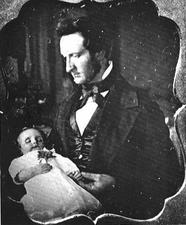One of the scenes that stays with me from Daniel Raeburn's New Yorker essay about how he and his wife dealt with the stillbirth of their daughter was the photographs. A nurse had assumed they would want to take some photos with their daughter as part of the mourning process, and offered to bring her body in for the photographer. Then she was surprised that the Raeburns opted not to do that; apparently, it was one of those things people do.
As it turns out, the nurse wasn't wrong. It was certainly something people did in the nineteenth century, when photography was first gaining popularity. At least one author traced the emergence of the modern notion of the nuclear family through the conventions of funerary photographs, where families posed together with their loved ones' remains. [The father's lost-looking stare in this photo is remarkable, both for the expressive grief it seems to convey, but also for its very existence; long exposure times made most portrayals of emotion very difficult to capture on camera. There's another of him with his wife and the baby on this page.]
On a graph, unfamiliarity with funerary photos--or bereavement photos, as they're now often called-- falls somewhere near the intersections of Americans' uncomfortable, arms-length relationship with death, the whipsawing grief of a baby dying, and the sheer cluelessness of new parents in general.
So for most people it's probably more than enough to just hear that an organization like Now I Lay Me Down To Sleep exists, and to tuck that fact away in the back of their brains. NILMDTS is a non-profit association of professional photographers who volunteer their services to "all parents experiencing the death of a baby."
Yeah, I'd kind of started this post out to be a purely historical interest kind of deal.
"Haunted When It Rains" gallery of 19th c. funerary photography [asu.edu via boingboing]
Now I Lay Me Down To Sleep, Infant Bereavement Photography [via this metafilter thread]
Related: Jay Ruby's book on the history of death and photography, Secure The Shadow [via this metafilter thread]
Previously: Daniel Raeburn writes about his stillborn daughter in the New Yorker


One thing these photos bring home is how much we've brought down infant and child mortality rates in just 100 years.
The U.S. had an infant mortality rate (first year of life) of 135 per 1000 births in 1911 vs. 6.5 per 1000 in 2005. (Singapore does best at 2.29)
Around 1900 nearly one out of every five children in the U.S. died before the age of five.
Inconceivable!
Mention that next time someone tells you they don't believe in childhood vaccinations. Knuckleheads.
I actually was familiar with funerary photos. That's a nice set. It is astounding how young many of those parents look.
Oy. Count me in for an uncomfortable arms length relationship with death and sheer terror at the thought of losing my son. I could only look at a couple of those pictures before moving on.
I collect dagguerrotypes and tintypes, and so had seen some like these befre.
Actually, the funerary photograph that has affected me most is one of the dad's (actually, my stepfather, so no blood relation, but still family) older brother, who had died of pneumonia at age 2. My dad's dad was actually a doctor, and his mother a nurse, so I can only imagine the pain of his death, which came in the pre-antibiotic era. He was laid out in lacey whites with blond cherubic curls. The stunner is that he was named for his father, a name which was passed on to my own dad who was born after his death.
Your post made me look up the Raeburn article, and read it. Something I really wish I hadn't done, something I really shouldn't have done. Eight months into a difficult high-risk pregnancy, 2 weeks away from a planned c-section (and perhaps only hours away from an unplanned emergency one, according to both my sets of ob/gyns), I really wish I hadn't let those thoughts in. Beautifully written though.